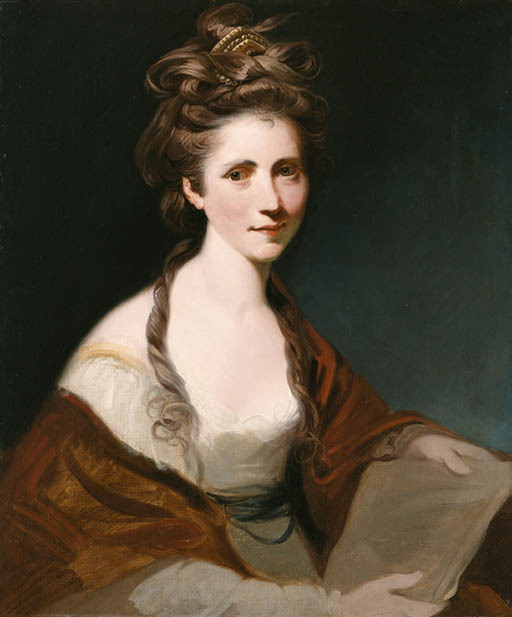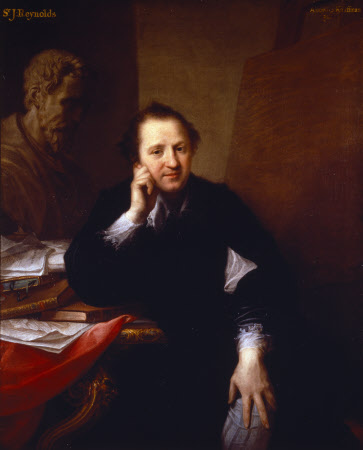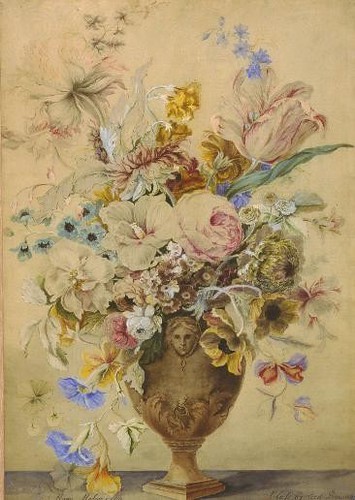
Source, The Fitzwilliam Museum, Cambridge, UK.
When Britain’s Royal Academy was founded in 1769, there were two women among the thirty-six founding members—Angelica Kauffman (also known as Maria Anna Angelika Kauffmann) and Mary Moser. Both were daughters of painters, and both were of Swiss descent. Also, both were born in late October, so this post falls under the heading of a birthday appreciation.
Angelica Kauffman
Born October 30, 1741—278 years ago today—Angelica Kauffman became famous across Europe as a Neoclassical painter. She specialized in history paintings, portraits, landscapes and decorations. Her father, artist Joseph Johann Kauffmann, trained his daughter. She worked as his assistant as the family moved through Switzerland, Austria and Italy.
Kauffman was a child prodigy, known for her artistic talent by age 12; but she also showed talent in music. Eventually she had to choose between the two arts. Later in her life, she portrayed the choice in this striking self-portrait:

A founding member of the Royal Academy, Kauffman exhibited with the RA annually from 1767 until 1782, when she left England for Rome. During her years in England, she became fast friends with Sir Joshua Reynolds; the two artists painted portraits of one another:


In a career that took in London, Dublin, Florence, Rome and Naples, Paris, Warsaw and St. Petersburg, Weimar and Vienna, she was known as the “Female Raphael of the Arts.” Her oeuvre includes some 800 oil paintings on canvas or copper, 13 frescos, 400 drawings, a small number of early pastels, and 41 etchings. Although a number of these are in private hands, many can be seen at the rotating exhibits of Austria’s Angelika Kauffmann Museum (established 2007), as well as at numerous other museums throughout the world.
Mary Moser
The only daughter of the Swiss artist George Michael Moser, Mary Moser was born on October 27, 1744. At the age of 14, she won her first medal from the Society of Arts, for her flower drawings. About ten years later, she became, at just 24 years old, the youngest Founder of the Royal Academy of Arts.

Like Angelica Kauffman, Mary Moser worked on portraits and historical subjects, but she is best known for her flower paintings. Because of her skill in this area, she was appointed drawing mistress to the Royal Princess Elizabeth. She was also awarded several royal commissions. Notable among these was the decoration of a room in Frogmore House, the country retreat of King George III’s wife, Queen Charlotte. Moser’s room—which is included in guided tours of the estate today—depicts English flower arrangements, both on large canvases and painted walls.

Not long after the completion of the Frogmore House commission, at the age of almost 50, Moser married. Like Angelica Kauffman, she carried on painting after her marriage. But unlike Kauffman, she ceased to work professionally. She did continue to exhibit as an honorary painter under her married name, Mary Lloyd.
A Limited Legacy
In the persons of Kauffman and Moser, women were represented at the Royal Academy’s founding. But it was more than one hundred years before the RA elected another woman (Dame Laura Knight, in 1936) to its ranks. In the interim, Kauffman and Moser were not particularly celebrated in RA lore.
In his painting The Academicians of the Royal Academy (1771–72), German painter Johan Zoffany includes Kauffman and Moser only as two half-finished portraits, hanging on a back wall. While the women founders are included as participants in Henry Singleton’s The Royal Academicians in General Assembly, their figures appear in the deep background of the assembled throng in the Council Room.

For an insightful overview of the Royal Academy’s relationship with Kauffman, Moser, and other women artists, see Amanda Vickery’s 2016 RA Magazine article, Hidden from history: the Royal Academy’s female founders.
Happy birthday to Angelica Kauffman and Mary Moser!
Opening in June 2020, the Royal Academy of Arts hosts ‘Angelica Kauffman,’ an exhibition that traces the artist’s trajectory from child prodigy to one of Britain’s most sought-after painters. Update, May 2020: Unfortunately, due to covid, the planned exhibition has been canceled.
Visit Art Herstory’s Angelica Kauffman resource page, here.
More Art Herstory birthday posts:
The Priceless Legacy of Artemisia Gentileschi
More Art Herstory posts about 18th-century artists:
Exhibiting Women: The Art of Professionalism in London and Paris, 1760–1830, by Paris Spies-Gans
Mary Linwood’s Balancing Act, by Heidi A. Strobel
Anna Dorothea Therbusch: A Woman Painting Against Eighteenth-century Odds, by Stephanie Pearson
Marie-Thérèse Reboul Vien: Finding the Natural in the Neoclassical, by Tori Champion
Rosalba Carriera at The Frick Collection, by Xavier F. Salomon
Adélaïde Labille-Guiard: Artist, Friend, Teacher, Guest post by Jessica L. Fripp
Angelica Kauffman and Mary Moser: Founding Women Artists of the Royal Academy
Seductive Surfaces: Anne Vallayer-Coster’s Vase of Flowers and Conch Shell at the Met, by Kelsey Brosnan
Marie-Guillemine Benoist, Revolutionary Painter, by Paris Spies-Gans
Angelica Kauffmann: Grace and Strength, Guest post by Anita V. Sganzerla
“I feel again the violence of a curious desire”: Rare client testimonies on Rosalba Carriera’s erotic art, Guest post by Angela Oberer
Rediscovering the Once Visible: Eighteenth-Century Florentine Artist Violante Ferroni, Guest post by Ann Golob




Trackbacks/Pingbacks